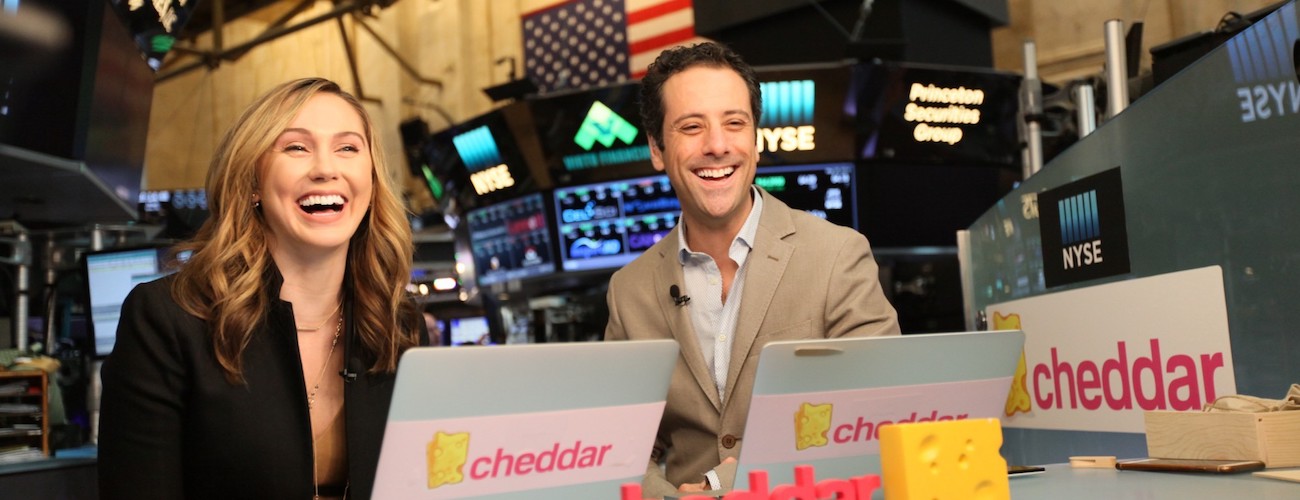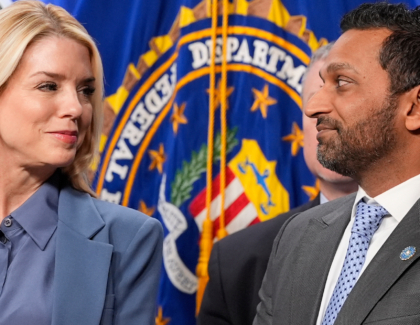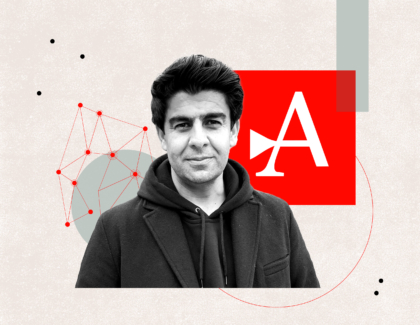Sign up for the daily CJR newsletter.
A former BuzzFeed executive’s contrarian bet on “post-cable” television appears to be paying off. Cheddar, which broadcasts on Twitter and streaming services such as Sling and Apple TV to a daily audience of about 1 million people, today announced a $19 million investment with funds from Amazon, AT&T, and the production company behind Saturday Night Live.
The latest financing round follows a $10 million investment led by Comcast late last year, and brings the company’s valuation to $85 million.
Jon Steinberg, a key architect of BuzzFeed’s business model, founded the network in early 2016. Cheddar live-streams eight hours of daytime programming, featuring twentysomething anchors, rapidfire interviews, sponsored segments, and coverage of buzzy stories in the realms of business, technology, entertainment, culture, and now politics. Broadcasts originate from the floor of the New York Stock Exchange, the Flatiron Building in Manhattan, and the White House.
Of particular interest to investors: Cheddar says 70 percent of its viewers are under 40, far outperforming networks on traditional cable, and company surveys suggest its audience is influential and educated.
In a talk at a recent conference hosted by the Society of American Business Editors and Writers, and in an interview afterwards with CJR, Steinberg talked about the rationale for his bet on Cheddar, where he sees the future of broadcast news, and his wariness in negotiating with the likes of Facebook.
Here are some of his insights, in his own words:
If you are doing what everybody else is doing, it’s too late. People still call me up and tell me they want to do BuzzFeed stuff. Doing BuzzFeed was a great idea in 2010. The idea of trying to do something somebody else has already done is almost guaranteed to be a failure. Trying to chase someone almost never works
When I came up with the idea of Cheddar, no one wanted to invest in it. Everybody told me it was a bad idea. And everybody told me there was no space to do business news—the idea of business news was a dying art. The 69-year-old viewers of Fox Business would fade away, and nothing new would come along. The data sort of holds that up, certainly around television news. Among those between the ages of 18 and 34, the data shows 30- to 42-percent declines in viewing hours in the past five years. That’s why I have so much loyalty to Jeremy (Liew, the first investor in Snapchat and also Cheddar’s initial investor). The people who love you when nobody loves you are really the people that matter. Now everybody wants to invest in the company.
ICYMI: Trump’s intelligence controversy destroys the defense his surrogates use to justify his actions
The logo is cheese with holes, but we’re called Cheddar. I self-funded the company in the beginning, and I always wanted to call it Cheddar. I felt like people would like it or hate it, and I’m in the marketing business. The designer I hired could not make the cheese look like anything other than a Trivial Pursuit piece. Once the holes went in it, it looked like cheese. It actually looks like a hybrid, a swiss-cheddar. Once that started irritating people I was even more overjoyed.
The conventional wisdom is that the future will have two kinds of video content. The first will be on-demand appointment viewing for highly produced dramas and comedies from leading services like Amazon and Netflix. The second is shitty little videos on Facebook. So the future will have highly produced dramas and comedies, shitty little videos on Facebook, and nothing in between.
You did not wake up a year ago and say, “Oh, I love shitty little 30-second videos on Facebook with no sound and text on the screen. If only I could find a media system that could give me a lot of 30-second videos with something provocative in the first half-second to catch my eye and to suck me in with text on the screen, that’s just the ideal kind of entertainment.” No! You didn’t do that. Facebook just ruined our world and created this weird sort of pipe where that was the only content that worked. It worked and worked and worked. It’s not good content; no one really wants it; it’s just what’s there.
Our bet is that the linear format—cable news—gets rebooted for people under 60. I’m not saying we’re going to be the only ones to do it. When you look at what happened with newspapers-to-Web, there were new people who came in—including BuzzFeed and Vox—and then The New York Times stayed around, too, and built a flourishing business across the chasm. The New York Times doesn’t have a lot of millennial readers getting the print edition, but they obviously have a lot of readers on the website.
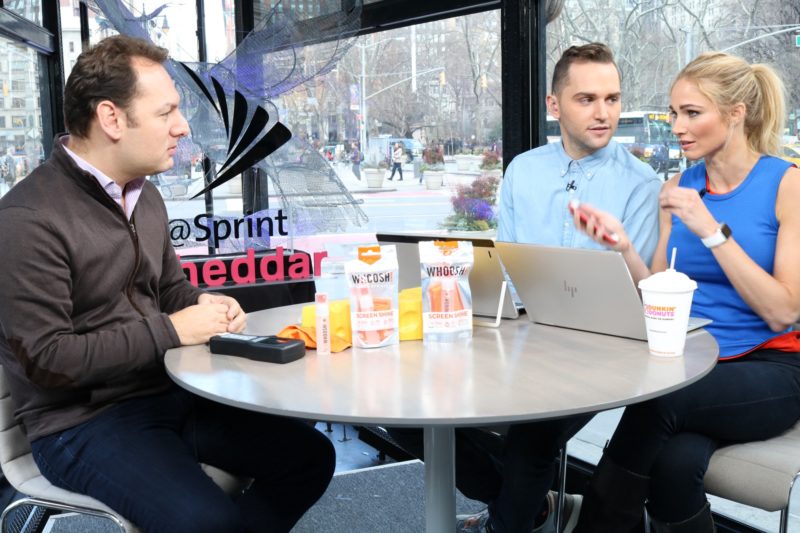
Cheddar anchors Baker Machado and Kristen Scholer interview a guest during a broadcast from the Flatiron Building in Manhattan. Courtesy photo.
People in their 60s are the ones who watch cable news. Therefore, the networks program for people in their 60s, and, therefore, there’s nothing on these networks for people under 60. The nice part about that [strategy] is it creates openings. It creates a bet for us that was very contrarian. I think we’re going to be right.
I’m in the cable-network business. I want to be Jeff Zucker when I grow up. That’s really how I think about Cheddar. I’m not thinking about websites. I’m not thinking about articles, or digital media. I want to be in skinny bundles; I want to have a cable network; I want to be on the dial next to Bloomberg and CNBC. I think it’s late to decide that you want to start from scratch and be a digital-media business. On the other hand, there’s relatively few people that are doing eight hours a day of live programming.
What are we doing precisely different? The answer is everything. We’re delivered completely differently—almost exclusively on these over-the-top platforms. All of our casting is younger—we have seven anchors; five of them are women under the age of 30. The topic mix is all technology, media, entertainment, and culture. The look and feel and color scheme is different. We break the fourth wall quite a bit to create more intimacy with the audience. On the day of the IPO for (cloud-based search provider) Yext, you had a 35-year-old founder taking public a billion-dollar company, which is a big story in New York on a relative basis. We covered it wall-to-wall. CNBC had him on air a few minutes before going to (JP Morgan Chase CEO) Jamie Dimon.
I think we have to be unbelievably wary in terms of allowing platforms to dictate our content. Whenever you talk to Facebook about monetization of our content, they’re always working on it and they care deeply. However, when it comes to them making money, somehow they always figure it out. When they really want something to work, they just get it done. When a platform tells you—for instance, “let us show you what works on YouTube”—I hearken back to third grade. And I say, “I’m free to be me.” We love ourselves. We make the content we want. And we’ll customize it 10 percent to work on your platform. But the platforms’ advice fundamentally is that we should make BuzzFeed content. I don’t believe in that, and I know there’s an audience for another kind of content.
My favorite episode of The Twilight Zone is “To Serve Man.” The aliens come down, and everyone’s very nervous. The aliens present to them this book with a foreign language. The aliens are super helpful, and the humans are working on translating the book and learn the book is titled, To Serve Man. As you can imagine, everyone is overjoyed and relieved. They’re here to serve mankind. This is amazing; these aliens are the best. (The punchline: It’s a cookbook.) If you do not know what’s for dinner, you are for dinner.
Coverage-wise, we definitely go for the lowest-hanging fruit. The nice thing is the lowest-hanging fruit is more substantive than a lot of what you see online. [Stories about] Amazon, Netflix, Facebook, Google, AirBNB, Elon Musk, space exploration, the new Apple watch, Samsung phone explosion. If you only chase numbers you’ll do the worst stuff—on Facebook Live anytime you put a face on the screen, the viewership goes down. Anytime you put a rocket on the screen, viewership goes up. If you follow the numbers, we would put a rocket taking off on loop all day long.
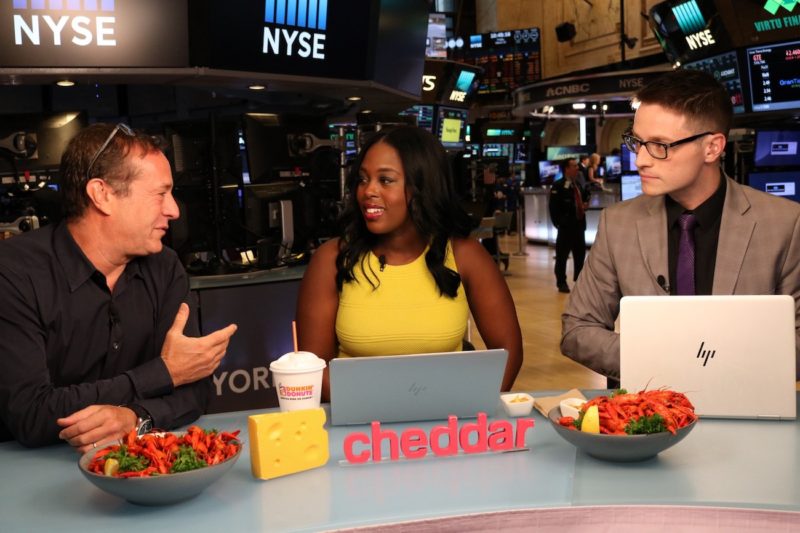
Cheddar anchors Kori Hale and J.D. Durkin interview a guest from the network’s studio at the New York Stock Exchange. Courtesy photo.
Initially, we went after existing business cable-news talent. It’s sort of a revolving door between Bloomberg, Fox Business, and CNBC. It’s a very structured process with negotiating periods. It’s very complicated. We went after these people, and we failed time and time again. Then what I learned is there are all these amazing producers and editors and writers who joined business cable networks with the desire to be on camera and were not getting those opportunities. That is where we found our sweet spot.
We need, as Hemingway put it, “a clean, well-lighted place.” We need to be vigilant about putting our content in places where it is “neighborhooded”; there is a logic to the cable-channel guide. And we have lot of great partners: I love Sling. We sit on a dial next to CNN and Bloomberg. That’s a logical place for us to be. I love Twitter. And it’s not just me that loves Twitter; Justin Smith (CEO at Bloomberg) loves Twitter, too. Cheddar is on Twitter live at 3 pm every day and is followed by Joe Weisenthal’s show (What’d You Miss?) on BloombergTV at 4 pm. There are a lot of people on Twitter who love stocks, who love business. There’s even a term for it: Finance Twitter. That’s “neighborhooding.” We also bought a few broadcasting licenses, too; seven million millennials bought HD antennas last year.
It’s hard to point to an example of people who made great high-quality programming in a distinct voice where they weren’t able to make the economics viable. What I like about what Vice has done is they’ve had a strong creative voice. They decided, this is what we’re going to make, and the numbers are going to be big enough. In most cases, that’s true. Where you get yourself into trouble is where you have no voice, you have no brand, you make what a platform tells you, and ultimately the platform decides to change what they want and you’re nothing.
Almost anything Netflix or HBO would propose to me, I would say yes. I might even make poor decisions when offered that opportunity. What we’re really good at is making live content and live-to-tape. What I would ideally like is for Netflix to put Cheddar in a skinny bundle. We want our linear programming in a lot of places. Also, the economics of produced video are so much worse than live. We do eight hours of live broadcast per day. Most days we book 40 to 50 guests; it’s tremendously efficient. We could turn around up to 100 pieces of content in a single day. A highly produced three-minute video could take days in an editing bay.
I wish the DNA in the legacy media companies was the DNA of the technology companies. In Silicon Valley, when a startup is exciting, there is much more of a desire [from] Google, Facebook, Twitter to engage with that company and figure out how to work together. The news media business views things as too much of a zero-sum game.
ICYMI: A Meryl Streep, Tom Hanks movie has former New York Times journalists pretty ticked off
Has America ever needed a media defender more than now? Help us by joining CJR today.



